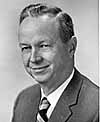
We sometimes have to wonder about the decision-making of government agencies. Senator Tom Coburn produced an annual list of waste and duplication that included science and it made sense to address those flaws, unless you actually favor National Science Foundation money being used so someone could play Everquest instead of doing actual science. Likewise, energy researchers were not thrilled that the Department of Energy funded the Human Genome Project.
But sometimes it makes total sense. Case in point: Dr. Ernest M. Allen, Chief, Division of Research Grants at the NIH, who once agreed to fund a rocket. For a 10-year-old.
In 1957, Terence Boylan loved rockets just like a lot of kids did. This was the decade of science-fiction on its way to becoming science fact. Boylan and a friend spent their free time looking at the books on rockets written by Werner von Braun and after learning all of the theory they could, they got application-intensive. They came up with a schematic for an aluminum rocket but they had spent their money on balsa wood prototypes. Terence asked his father, medical researcher Dr. John Boylan, where he got his funding, and his father replied "the NIH."
So Terence wrote the NIH, like any enterprising kid would do:
My friend and I are very interested in space travel and have a great idea for a rocket ship. We were wondering if we could have a little sum of money($10.00) to fulfill our project.It reached the desk of Dr. Allen, who clearly had important work to do - this was right after the success of the first vaccine and the government smartly declared it was worthwhile trying to fight disease in advance in American laboratories rather than after-the-fact in American hospitals - but he nonetheless read the proposal to the committee.
We would [be] most grateful if you would send it to us.
Sincerely, Terence Boylan
It was, understandably, rejected. There can be some overlap between agencies but the NIH funding a rocket was a bit too much. Allen replied personally:
Dear Terence:It wasn't without some hurdles but they built a 4 foot rocket and launched it with a mouse inside. It landed 10 miles away, they were wise enough to include their phone number and the person who found it called, and their father drove them over to retrieve it and the mouse was fine. Good luck getting ethical approval for that from the NIH today.
Your request for $10.00 in support of your rocket ship project was read to the National Health Advisory Council on March 12. The members of the Council agreed that your proposal does not fall in the health and related sciences fields for which they recommend research support. On the other hand, they agreed enthusiastically that you should receive the funds requested and contributed as individuals to make the support possible.
In accordance with the wishes of the council, I am therefore pleased to forward my check in the amount of $10.00. Please accept our very best wishes for a successful project.
Sincerely yours, Ernest M. Allen, Sc.D.
Chief, Division of Research Grants
Despite his love for rockets, Boylan did not become a scientist or engineer. Instead, he pursued music. He got a recording contract and formed a band with Walter Becker and Don Fagen, who would later become famous as Steely Dan. His brother went on to become a producer and connected him with Linda Ronstadt, Bonnie Raitt and the Eagles, along with having his own successful solo career.
He still has an admiration for science. He is Executive Director of the Boylan Foundation for International Medical Research, created in honor of his father, and over a thousand medical students and post-doctoral fellows have gotten funding from it.
In his write-up of the story, Don Luckett of the Center for Scientific Review (which was previously Allen's DRG) at the NIH quoted G.K. Chesterton “I’ve searched all the parks in all the cities and found no statues of committees” but surely all those 14,000 researchers who sit on grant committees for no reason other than the love of science can at least get a little thanks. One committee certainly got thanks from the young man, along with some hometown media attention for getting funded at age 10.
Top image credit: NIH




Comments